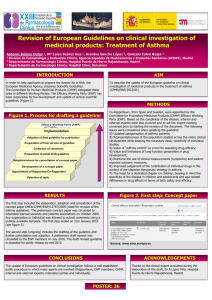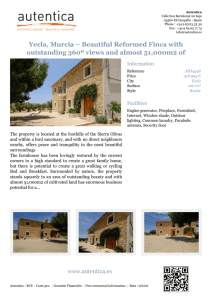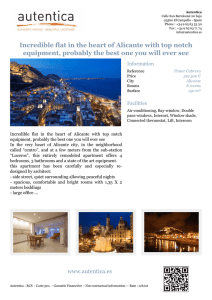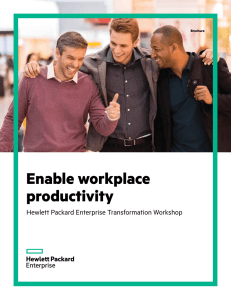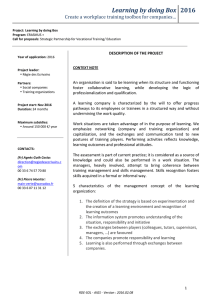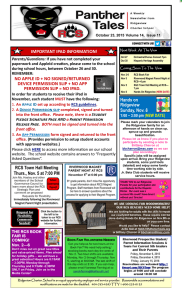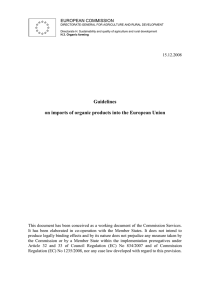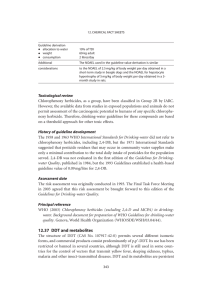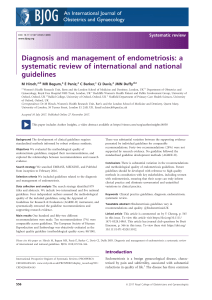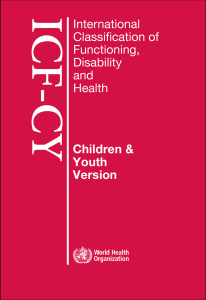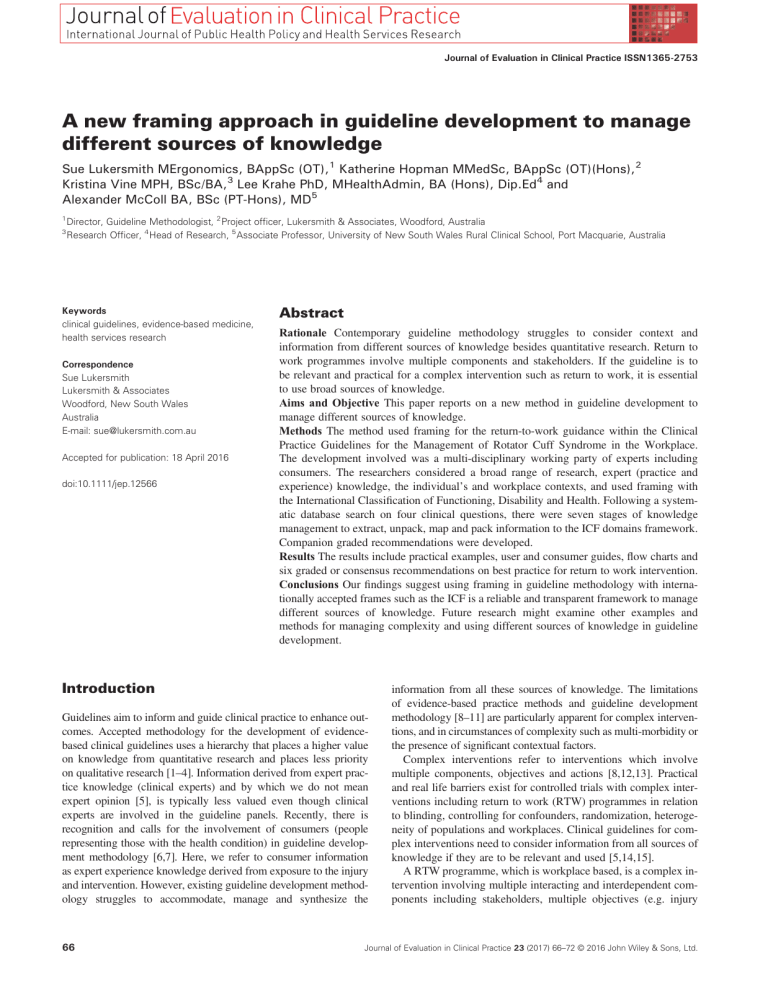
bs_bs_banner Journal of Evaluation in Clinical Practice ISSN1365-2753 A new framing approach in guideline development to manage different sources of knowledge Sue Lukersmith MErgonomics, BAppSc (OT),1 Katherine Hopman MMedSc, BAppSc (OT)(Hons),2 Kristina Vine MPH, BSc/BA,3 Lee Krahe PhD, MHealthAdmin, BA (Hons), Dip.Ed4 and Alexander McColl BA, BSc (PT-Hons), MD5 1 3 Director, Guideline Methodologist, 2 Project officer, Lukersmith & Associates, Woodford, Australia Research Officer, 4 Head of Research, 5 Associate Professor, University of New South Wales Rural Clinical School, Port Macquarie, Australia Keywords clinical guidelines, evidence-based medicine, health services research Correspondence Sue Lukersmith Lukersmith & Associates Woodford, New South Wales Australia E-mail: sue@lukersmith.com.au Accepted for publication: 18 April 2016 doi:10.1111/jep.12566 Abstract Rationale Contemporary guideline methodology struggles to consider context and information from different sources of knowledge besides quantitative research. Return to work programmes involve multiple components and stakeholders. If the guideline is to be relevant and practical for a complex intervention such as return to work, it is essential to use broad sources of knowledge. Aims and Objective This paper reports on a new method in guideline development to manage different sources of knowledge. Methods The method used framing for the return-to-work guidance within the Clinical Practice Guidelines for the Management of Rotator Cuff Syndrome in the Workplace. The development involved was a multi-disciplinary working party of experts including consumers. The researchers considered a broad range of research, expert (practice and experience) knowledge, the individual’s and workplace contexts, and used framing with the International Classification of Functioning, Disability and Health. Following a systematic database search on four clinical questions, there were seven stages of knowledge management to extract, unpack, map and pack information to the ICF domains framework. Companion graded recommendations were developed. Results The results include practical examples, user and consumer guides, flow charts and six graded or consensus recommendations on best practice for return to work intervention. Conclusions Our findings suggest using framing in guideline methodology with internationally accepted frames such as the ICF is a reliable and transparent framework to manage different sources of knowledge. Future research might examine other examples and methods for managing complexity and using different sources of knowledge in guideline development. Introduction Guidelines aim to inform and guide clinical practice to enhance outcomes. Accepted methodology for the development of evidencebased clinical guidelines uses a hierarchy that places a higher value on knowledge from quantitative research and places less priority on qualitative research [1–4]. Information derived from expert practice knowledge (clinical experts) and by which we do not mean expert opinion [5], is typically less valued even though clinical experts are involved in the guideline panels. Recently, there is recognition and calls for the involvement of consumers (people representing those with the health condition) in guideline development methodology [6,7]. Here, we refer to consumer information as expert experience knowledge derived from exposure to the injury and intervention. However, existing guideline development methodology struggles to accommodate, manage and synthesize the 66 information from all these sources of knowledge. The limitations of evidence-based practice methods and guideline development methodology [8–11] are particularly apparent for complex interventions, and in circumstances of complexity such as multi-morbidity or the presence of significant contextual factors. Complex interventions refer to interventions which involve multiple components, objectives and actions [8,12,13]. Practical and real life barriers exist for controlled trials with complex interventions including return to work (RTW) programmes in relation to blinding, controlling for confounders, randomization, heterogeneity of populations and workplaces. Clinical guidelines for complex interventions need to consider information from all sources of knowledge if they are to be relevant and used [5,14,15]. A RTW programme, which is workplace based, is a complex intervention involving multiple interacting and interdependent components including stakeholders, multiple objectives (e.g. injury Journal of Evaluation in Clinical Practice 23 (2017) 66–72 © 2016 John Wiley & Sons, Ltd. S. Lukersmith et al. recovery, RTW and income maintenance), components (e.g. assessment through to review and ensuring sustainability) and activities (e.g. workplace assessment, job analysis, development and upgrading of work tasks, education of stakeholders and facilitating workplace accommodations). The context of RTW programmes adds further complexity. The context refers to the environment in which the intervention occurs, the workplace and nature of the work, the services and technology, the attitudes, the support, responsibilities and relationships and the services systems and policies. Context also refers to the injured worker’s personal factors such as their social situation, age, gender, life experiences and education [16]. The development of guidelines for RTW programmes for people with rotator cuff syndrome (RCS) requires careful attention to the many contextual factors, components and stakeholders. It is essential to consider the different sources of knowledge if the guideline is to be relevant, applicable and practical for the target users. A new methodological approach for the development of clinical guidelines is needed which uses and manages the sources of knowledge and information. The sources of knowledge to consider with a RTW guideline include quantitative research evidence, qualitative research evidence, contextual information (e.g. the workplace, legal requirements and the injured person’s work skills), expert practice knowledge (clinical and workplace) and expert experience knowledge (consumers and the injured worker). Clinical questions considered in a RTW guideline are broader than the specific treatment of body and structure impairments and relate to the context of the RTW programmes and outcomes. An example is ‘What are the barriers and facilitators to a return to work (RTW) following RCS?’ Quantitative research cannot answer these questions. The contextual factors that influence the injured person’s functioning at the workplace such as regulations, workplace management knowledge and practice need to be considered and therefore requires the use of all sources of knowledge. The use of frameworks to manage complexity issues is emerging in health research. Taxonomies have been developed to enhance understanding and research on the effectiveness of complex interventions such as behaviour change [17], falls prevention programmes [18] and health-related habits and lifestyle [19]. Logic modelling was used to review evidence for complex interventions [20], grounded theory for categorization of interventions and a precursor to evidence synthesis [21]. The International Classification of Functioning, Disability and Health (ICF) [16] was developed after extensive work by an international network and published in 2001 by the World Health Organization. The aim of the classification was to provide a unified and standard language to describe health and health-related states. As such, the ICF provides a common language and framework to understand functioning, disability and health, but importantly recognizes the influence of the environment and personal factors on functioning [16,22]. The ICF is increasingly used in health and rehabilitation research [23] patient management, intervention design and reporting on health [24]. The related field of ergonomics has conceptually linked the ICF to practice [25]. S. L. used the ICF to inform the development of two previous guidelines [26,27]. The ICF is an appropriate framework to use in combination with best practice guideline methodology for the development of RTW programme guidelines. © 2016 John Wiley & Sons, Ltd. Framing different sources of knowledge This paper reports on the new framing guideline development approach that considered different sources of knowledge then unpacked and packed the information within a health research framework, the ICF to develop the RTW work guidelines. It was part of a larger study to develop the comprehensive Clinical Practice Guidelines for the Management of Rotator Cuff Syndrome in the Workplace [28] finalised in 2013 and available on the following link http://rcs.med.unsw.edu.au/clinical-practice-guidelines. Method The guidelines development was in conjunction with a multidisciplinary working party of practice knowledge experts (two general practitioners, three allied health care providers, four medical specialists, two guideline methodologist and developers and two researchers) and experience knowledge experts (two consumer representatives). For the RTW component of the guidelines, the working party developed four clinical questions. The questions were as follows: 1. What factors should be considered for a RTW programme? 2. What are the barriers and facilitators to a RTW? 3. When should a RTW be considered for RCS? 4. How should a RTW programme be implemented following RCS? An extensive search of 14 national and international guideline development organizations and guideline repositories were searched in September 2011 [29] to identify any existing evidence-based guidelines that answered the clinical questions and were relevant, or adaptable, to the Australian context. Of five existing and related guidelines identified [30–34], two briefly referred to RTW, but none answered the clinical questions. Systematic literature search on the clinical questions The working party agreed to systematically search for contemporary practice research literature (January 2000 and 2012). In order to utilise all sources of knowledge, no study methodology filters were used. S. L. and K. H. completed the systematic searches for studies on each clinical question. Databases searched include MEDLINE, EMBASE, CINAHL, Cochrane, PEDro, OT Seeker and PychINFO. The search strategy is outlined as follows: Search 1 The rotator cuff syndrome key terms were as follows: rotator cuff syndrome shoulder pain/or shoulder pain.mp or rotator cuff/or rotator cuff or shoulder impingement syndrome/or shoulder impingement.mp or bursitis/or bursitis.mp or (shoulder$ or rotator cuff or subacromial), (bursitis or impingement or tendonitis or tendinitis or tendinopathy or pain$), infraspinatus, supraspinatus, subscapularis, (tear AND minor) AND (tear OR impingement). Search 2 The key terms for RTW were; work$.mp, work, work.mp Search 3 and subsequent searches The key words for contextual and workplace factors were as follows: • work capacity, work capacity evaluation, work schedule tolerance, work simplification, workplace, employment, return to work, vocational, rehabilitation, disability evaluation/or work capacity evaluation, activities of daily living, graded return to work, return$ and work$, occupational 67 S. Lukersmith et al. Framing different sources of knowledge • attitude, attitude$, attitude to health, employer attitude, personnel, age of onset/or age factors/or age, personnel management/or personnel selection/or attitude/or prejudice, prognosis. The combined search of key words (1) and (2) then these results combined with each of the contextual factor key terms (3) separated with Boolean term (e.g work capacity “OR” evaluation). The database literature searches were supplemented by hand searching and screening the reference list of all relevant studies. S. L. and K. H. screened abstracts for potential inclusion and reached agreement on the studies to be included. For final inclusion, studies had to fulfil all of the following criteria: examine RCS [including shoulder impingement syndrome, subacromial impingement syndrome, subacromial bursitis, rotator cuff tendonitis and rotator cuff tears (partial or full thickness)], address RTW approaches, written in English and participants were adults (18–65 years of age). Further inclusion criteria related to the activity and type of work in which the study participants performed. Studies were included if they examined work tasks associated with higher incidences of rotator cuff injury including: heavy lifting, the use of ‘high’ hand force for 1 hour or more per day, repetitive shoulder movements, overhead work that required upper arm elevations of greater than 900, and use of vibrating tools [35]. Studies that examined the following occupations with higher incidence and stronger associations with rotator cuff syndrome were included: construction workers, car assembly workers, forestry workers, agriculture, meat and/or fish processing, onerous human services such as cleaners, nurses and personal care assistants. The exclusion criteria were studies examining shoulder diagnoses that involved a different mechanism including shoulder instability, adhesive capsulitis or labral lesions. Studies that involved occupations not associated with rotator cuff syndrome were excluded including sedentary or office based work occupations. Two reviewers appraised each study (combination of S. L., K. H. and/or a research associate) using the following appraisal tools: an adapted and expanded National Health Medical Research Council checklist for quantitative studies [36] combined with Partitioned PEDro scale (Physiotherapy Evidence Database, 2009) for randomized controlled trial intervention studies, Critical Appraisal Skills Programme for appraisal of systematic reviews and Critical Appraisal Skills Programme for qualitative studies [37] and single case experimental design scale for appraisal of single case studies [38]. Information extraction Identified studies were broadly separated into three groups: those focused on RTW specifically, those focused on recovery generally and studies which referred to injured workers with persistent problems and were unable to RTW. Subsequently, different techniques used across seven stages involved extraction of information and knowledge management. Refer to Table 1 for an overview of the stages of knowledge management described below. Table 1 Stages of knowledge management Activity Performed by Literature search Stage 1 2 3 4 5 6 7 Multiple database searches Papers excluded by abstracts and eligibility Study appraisal Information extraction Authors S. L. and K. H. Relevant information extracted from papers and unpacked the key factors from studies reported to influence RTW. Categories recorded were - Study details - Description of factor - Whether reported as barrier or facilitator to RTW - Strength of evidence - Consistency across studies - Group concerns or issues from group (e.g whether consistent with their knowledge) Factors mapped to the ICF Consensus on factors and groupings according to ICF Information from prognostic studies grouped with factors listed through Stage 1 Groupings of factors (Stages 1 and 2), principles and standards reviewed (Stage 4) Consensus on grouping of factors as red or yellow flags Extracted best practice principles and elements identified in papers Gap analysis of elements missing Grey literature search for statutory requirements, information on ethics, values and principles (additional source of knowledge) Synthesis of information from Stages 2 and 5 using the ICF framework Review, revision and consensus Associated recommendations drafted Review, revision and consensus Working party Two people per paper (S. L., K. H. and a research associate) First author Working party Authors S. L. and K. H. Working party First author Working party First author and three working party members First author Working party Authors S. L. and K. H. Working party ICF, International Classification of Functioning, Disability and Health; RTW, return to work. 68 © 2016 John Wiley & Sons, Ltd. S. Lukersmith et al. Stage 1: The working party extracted information from studies, which focused on RTW programmes and recovery. Over two working party meetings, a transparent nominal group technique [39–41] was used to develop consensus. The nominal group technique allows for a structured approach and judgement to develop consensus. It involves open group discussions around a particular question involving the information from the literature, expert practice and experience knowledge of group members. Discussion continues until agreement with all participants was achieved. The working party divided into three small groups with each reviewing different studies to unpack, and extract information on the key factors reported in the research to have influenced RTW. The information was tabulated into the following: the study details and description of the factor, comment on whether the factor was reported as a barrier or facilitator, whether the evidence was strong or consistent across studies, concerns or issues the group members had and whether their work experience confirmed the factor or not. The small groups reached a consensus on the factors derived from the literature. S. L. (who was the most experienced with the ICF) used the ICF definitions to map the factors to the ICF and pack them into groups related to the domains of body function and structure, activities and participation and contextual (personal and environmental). At the subsequent working party meeting, the whole group reviewed the combined tables and reached a consensus on the factors and groupings. Stage 2: K. H. extracted the factors which influenced recovery (prognosis) from studies which focused on people with persistent problems and did not RTW. S. L. and K. H. then combined these with the first list of factors developed through Stage 1 so that all were mapped to the ICF framework. Stage 3: At the end of Stage 2, the prognostic factors that influenced recovery and the barriers and facilitators for RTW identified through method 1 and 2 were reviewed with the working party. These were then grouped and framed as red or yellow flags [42]. Yellow flags for the purpose of the RCS guidelines include the contextual factors as defined in the ICF: personal and environmental factors, which may be barriers to recovery and increase the risk of long-term disability. The working party used their expert practice and expert experience knowledge and reviewed the list of yellow flags, principles and standards for RTW interventions (refer to Stages 4 and 5 later). The red flags, referred to the signs and symptoms associated with serious pathology. Stage 4: S. L. extracted the information on principles and elements identified in the studies to be associated with best practice or beneficial for RTW interventions. These were broadly mapped to the ICF contextual factors related to the environment and RTW intervention practice elements. Stage 5: A gap analysis undertaken at the next working party meeting identified elements of RTW interventions known to be important in practice that were not identified in the studies nor in the study’s scope. The elements identified in the gap analysis necessitated further © 2016 John Wiley & Sons, Ltd. Framing different sources of knowledge searching for grey literature1, standards and statutory requirements. For example, it was appropriate to include the RTW hierarchy (p.36) [28]. The hierarchy articulates a stepwise consideration of the goal of RTW programmes dependent on the person’s recovery and context. The first goal preference in the hierarchy is for the person to RTW in the same job with the same employer, through six levels to the last goal of a new job with a new employer. It was also necessary to identify information and concepts from other disciplines (e.g. human factors and ergonomics) not identified in the RCS specific studies, around topics such as job analysis (as distinct from workplace assessment). Expert practice and experience knowledge, ethics and human and work value principles further guided the development of RTW principles: for example, the principle that RTW programmes should target duties that are value added, meaningful and productive to the injured person and employer, rather than demeaning duties which are often referred to as ‘time wasters’ programmes. Stage 6: The information arising from Stages 2 and 5 was further synthesized by S. L. The information was grouped using the ICF domains and definitions of environmental factors as these were potentially facilitators for the overall RTW approach and the intervention. The placement of factors into these groups was further refined following discussion until there was agreement with all members of the working party. Stage 7: Finally, using guideline methodology [29,43], S. L. and K. H. drafted recommendations in line with the evidence. The working party reviewed, discussed and adjusted the wording of the recommendations but which remained consistent with the research evidence and other sources of knowledge. S. L. and K. H. drafted the grade of the recommendation using the National Health Medical Research Council grading matrix and A, B, and C grades [43] and which was then discussed and endorsed by the working party. Other recommendations based on all sources of knowledge (not only research studies) developed by the working party used a modified Delphi technique [39] and were graded Consensus. Results The results of the literature search on studies looking at RTW (n = 26) are presented in tables of evidence. Because of their length, details of the tables are available in the technical report of the complete guidelines (p. 54–62) [29] available on http://rcs.med.unsw. edu.au/clinical-practice-guidelines. The tables of evidence provide the study details, level of evidence, study description, study outcome and findings and comments arising from the study appraisals. Synthesis of the evidence within these tables forms the basis of the guideline recommendations and resource materials, which were developed from the seven stage process of evidence extraction, integration and 1 Grey literature refers to research that is either unpublished or has been published in non-commercial form. It includes papers, reports, technical notes or other documents produced and published by governmental agencies, academic institutions and other groups that are not distributed or indexed by commercial publishers. 69 S. Lukersmith et al. Framing different sources of knowledge mapping for the clinical guidelines. Full details are available in the complete guideline and with an overview provided here. At the completion of Stage 3, Tables of red flags and yellow flags were developed. Yellow flags which impact on recovery and RTW and which should be considered by the health care provider at the initial presentation of the injured person are detailed in the complete guideline (refer to section p. 26) [28]. The 12 yellow flags to consider included age, gender, pain intensity, fear avoidance, duration of symptoms, unemployment, level of education, worker’s compensation status, health statues, perceived level of job demands/control, body mass index and culture. A consensus-graded recommendation was developed to highlight the list of yellow flags to the guideline user that is ‘The clinician should take note of “yellow flags” discussed or identified during history-taking. “Yellow flags” are contextual factors such as personal, psychosocial or environmental factors that could impact on recovery and/or RTW following injury’. The results from Stages 5–7 of the knowledge management process are incorporated into the treatment section of the guidelines. RTW programmes guidance is provided in the non-surgical treatment section: 8.2 RTW programmes. The recommendations relating to RTW are provided in the Appendix. The ICF contextual factors relevant to RTW and located in research evidence are also defined and examples provided. Examples of practice knowledge of the contextual factors include the standards for a RTW goal and preferred hierarchy. A case example of a poorly developed, RTW programme provided in the guidelines aimed to demonstrate an inappropriate goal and how the presence of yellow flags, environmental barriers and personal factors contributed to the case outcome and time delays (refer p.37) [28]. The results from Stages 4–6 included the identification of the contextual facilitators and best practice elements for the overall RTW approach. The six standards for the overarching approach are as follows (refer to the complete guideline for details and levels of evidence http://rcs.med.unsw.edu.au/clinical-practice-guidelines): 1. A team approach (multidisciplinary/multi-modal rehabilitation) 2. Patient centred, patient involved 3. Provision of income support 4. Workplace-based 5. Role of supervisor 6. Employer policies and systems In Stage 5, the gap analysis by the working party identified the following factors: job analysis, establishment of RTW goal, the timing of establishing a RTW goal, the nature of the duties, outcome measurement and coordination as additional elements for best practice standards. These are included in 14 best practice standards for the RTW intervention. The standard headings are listed later (refer to the complete guidelines for details and levels of evidence http://rcs.med.unsw.edu.au/clinical-practice-guidelines). 1. Contact between the healthcare provider and the workplace 2. Early contact with the injured worker 3. Workplace assessment 4. Job analysis 5. RTW goal and time frames are established early 6. Graded RTW 7. Duties are ‘value added’ 8. Co-ordination through case management/RTW coordinator 9. Workplace accommodations 10. Outcomes measured, intervention progress monitoring and intervention reviewed 70 11. Education and training 12. Physical conditioning 13. Psychological treatment 14. Communication There were six RTW recommendations developed. In addition, the results from the literature search and knowledge management steps were used to develop plain English practical resources to enhance implementation and user uptake. The information on the standards for the approach and the intervention were transposed into two plain English guides; the General Practitioner (available on https://rcs.med.unsw.edu.au/sites/default/files/rcs/ page/Resources_GP_ReturnToWork.pdf) and employer (p.59) [28] (available on https://rcs.med.unsw.edu.au/clinical-practiceguidelines). Some information on RTW is also included in an information sheet intended for use by consumers (available on https://rcs.med.unsw.edu.au/clinical-practice-guidelines). The consumer representatives on the working party were significantly involved in the development and wording of the consumer document together with KV. The comprehensive guidelines include flow charts, although the development of a flow chart for the RTW intervention alone was not possible because of the heterogeneity of the potential workplace and industry variations in policies, systems and procedures. Discussion This paper presents a new methodological approach to manage the use of different sources of knowledge to develop a guideline for a complex intervention, RTW for persons with rotator cuff syndrome. The RTW guidelines were part of a larger study to develop clinical practice guidelines for the management of RCS in the workplace. The guideline working party developed four clinical questions. A systematic search and appraisal of the research evidence identified limited quantitative and qualitative studies. The differences in study methods, parameters of the RTW programmes, populations and contexts meant standard guideline development methods using quantitative evidence synthesis to develop recommendations was not possible. In order to answer the clinical questions, develop guidance material and use wider sources of knowledge to identify contextual factors influencing outcomes; a new approach for information synthesis was needed, one which maintained the integrity and transparency of best practice guideline methodology. Frameworks in health sciences research is an emerging practice to manage complexity. The ICF as a classification, representation of the biopsychosocial model of functioning and a conceptual framework has been used in health and rehabilitation research. The methods to develop the RTW guideline involved using different sources of knowledge (quantitative and qualitative research evidence, expert clinical and workplace practice and experience knowledge and contextual information) framed in a health research framework (ICF) and standard guideline methodology to develop the RTW guidelines. Information was unpacked, then mapped and packed to the ICF domains framework, and companion graded recommendations developed. The first three phases of the study resulted in the identification of contextual factors (environmental and personal) in line with the ICF framework and concepts, which influence recovery and RTW following RCS. There is a related consensus recommendation, which directs the guideline user to consider these factors. The © 2016 John Wiley & Sons, Ltd. S. Lukersmith et al. results of using the ICF framework in the subsequent phases 4–7 include practical examples, user and consumer guide’s components for flow charts and 6-graded or consensus recommendations on best practice for the RTW approach and intervention. Standard guideline development is based on methods which uses knowledge from research evidence. The limits on the source of knowledge and evidence to quantitative research studies, is inadequate to address guidelines for complex interventions such as RTW programmes. The ICF is a framework that enables guideline developers to unpack information from all sources of knowledge, map, group (pack) and frame the information to develop practical clinical guidelines and resources. Limitations of study Standard guideline methodology and evidence synthesis and the development of guideline recommendations demand that only studies that involve the health condition under guideline development is used. Only studies involving RCS were included in the development of RTW guidelines. This has limited the depth and detail of the guidance material. The careful consideration and generalizability of RTW programme study results for health conditions other than RCS should be considered in future revisions of the guideline. Conclusions Our findings suggest that the use of the ICF is a reliable and transparent framework to manage information from different sources of knowledge. It is appropriate to further explore the use of ICF as a framework for the development of other clinical practice guidelines for complex interventions. Future research is needed into other methods for managing information from different sources of knowledge in the development of guidelines and particularly with complex interventions and across contexts. Framing different sources of knowledge 2. 3. 4. 5. 6. 7. 8. 9. 10. 11. 12. 13. 14. Conflict of interest The authors declare they have no conflicts of interest. The funding organization Essential Energy, was not involved at any stage of the guideline development. As the guidelines were developed in complete isolation of the funding body, their views or interests have not influenced the recommendations or the guidelines. Acknowledgements 15. 16. 17. 18. The authors wish to thank the 10 members of the working party for their expert practice and experience knowledge and generously giving their time. The development of the guidelines was supported by a grant from Essential Energy in Port Macquarie, NSW, Australia. 19. Author contributions 20. The research involved all authors. S. L. wrote the draft manuscript with all other authors contributing to further drafts and comments. 21. References 1. National Health and Medical Research Council (2011) Procedures and requirements to meet the 2011 NHMRC standard for clinical practice © 2016 John Wiley & Sons, Ltd. 22. guidelines. Canberra: NHMRC, Editor. https://www.nhmrc.gov.au/ guidelines-publications (last accessed 21 August 2011). Goldet, G. & Howick, J. (2013) Understanding grade: an introduction. Journal of Evidence-Based Medicine, 6 (1), 50–54. Qaseem, A., Forland, F., Macbeth, F., Ollenschlager, G., Phillips, S. & van der Wees, P. (2012) Guidelines International Network; toward international standards for clinical practice guidelines. Annals of Internal Medicine, 156, 525–531. AGREE II: Advancing guideline development, reporting and evaluation in healthcare [Internet] (2010). http://www.agreetrust.org/. [cited September 2011]. Salvador-Carulla, L., Fernandez, A., Madden, R., Lukersmith, S., Colagiuri, R., Torkfar, G. & Sturmberg, J. (2014) Framing of scientific knowledge as a new category of health care research. Journal of Evaluation in Clinical Practice, 20 (6), 1045–1055. Schunemann, H. J., Fretheim, A. & Oxman, A. D. (2006) Improving the use of research evidence in guideline development: 10. integrating values and consumer involvement. Health Research Policy and Systems, 4, 22. G-I-N Public Working Group (2015) G-I-N public toolkit: patient and public involvement in guidelines Guidelines International Network (GIN). Craig, P., Dieppe, P., Macintyre, S., Michie, S., Nazereth, I. & Petticrew, M. (2008) Developing and Evaluating Complex Interventions: New Guidance. London: Medical Research Council (MRC). Shepperd, S., Lewin, S., Straus, S., Clarke, M., Eccles, M. & Fitzpatrick, R. (2009) Can we systematically review studies that evaluate complex interventions? PLoS Medicine, 6 (8, e1000086). Michie, S., Fixsen, D., Grimshaw, J. & Eccles, M. (2009) Specifying and reporting complex behaviour interventions. Implementation Science, 4 (40), doi:10.1186/1748-5908-4-40. Fernandez, A., Sturmberg, J., Lukersmith, S., Madden, R., Torkfar, G., Colagiuri, R. & Salvador-Carulla, L. (2015) Evidence-based medicine: is it a bridge too far? Health Research Policy and Systems, 13 (1), 66. Petticrew, M. (2011) When are complex interventions ’complex’? When are simple interventions ’simple’? European Journal of Public Health, 21 (4), 397–398. Medical Research Council (2008) Developing and evaluating complex interventions:new guidance. MRC. Zuiderent-Jerak, T., Forland, F. & Macbeth, F. (2012) Guidelines should reflect all knowledge, not just clinical trials. BMJ, 345, e6702. Greenhalgh, T., Howick, J. & Maskrey, N. (2014) Evidence Based Medicine Renaissance G. evidence based medicine: a movement in crisis? BMJ, 348, g3725. World, Health, Organisation, (WHO) (2001) International Classification of Functioning, Disability and Health. Geneva: WHO. Abraham, C. & Michie, S. (2008) A taxonomy of behavior change techniques used in interventions. Health Psychology, 27 (3), 379–387. Lamb, S., Becker, C., Gillespie, L., Smith, J., Finnegan, S., Potter, R., Pfeiffer, K. & Taxonomy Investigators (2011) Reporting of complex interventions in clinical trials: development of a taxonomy to classify and describe fall-prevention interventions. Trials, 12, 125:8 pages Salvador-Carulla, L., Alonso, F., Gomez, R., Walsh, C., Almenara, J., Ruiz, M., Abellán, M. J. & eVITAL group (2013) Basic concepts in the taxonomy of health-related behaviors, habits and lifestyle. International Journal of Environmental Research and Public Health, 10, 1963–1976. Anderson, L. M., Petticrew, M., Rehfuess, E., Armstrong, R., Ueffing, E., Baker, P., Francis, D. & Tugwell, P. (2011) Using logic models to capture complexity in systematic reviews. Research Synthesis Methods, 2 (1), 33–42. Gardner, B., Whittington, C., McAteer, J., Eccles, M. & Michie, S. (2010) Using theory to synthesise evidence from behaviour change interventions: the example of audit and feedback. Social Science & Medicine, 70, 1618–1625. Utsun, T. B., Chatterjee, S., Bickenbach, J., Kostanjsek, N. & Schneider, M. (2003) The International Classification of Functioning, Disability and 71 Framing different sources of knowledge 23. 24. 25. 26. 27. 28. 29. 30. 31. 32. 33. 34. 35. 36. 37. 72 Health: a new tool for understanding disability and health. Disability and Rehabilitation, 25 (11-12), 565–571. Fayed, N., Cieza, A. & Bickenbach, J. E. (2011) Linking health and health-related information to the ICF: a systematic review of the literature from 2001 to 2008. Disability and Rehabilitation, 33 (21-22), 1941–1951. Kostanjsek, N., Rubinelli, S., Escorpizo, R., Cieza, A., Kennedy, C., Selb, M., Stucki, G. & Üstün, T. B. (2011) Assessing the impact of health conditions using the ICF. Disability and Rehabilitation, 33 (15-16), 1475–1482. Leyshon, R. T. & Shaw, L. E. (2008) sing the ICF as a conceptual framework to guide ergonomic intervention in occupational rehabilitation. Work, 31 (1), 47–61. EnableNSW and Lifetime Care & Support Authority (2011) Guidelines for the prescription of a seated wheelchair or mobility scooter for people with a traumatic brain injury or spinal cord injury. Sydney: EnableNSW and LTCSA Editor. Motor Accidents Authority NSW (2008) Guidelines for mild traumatic brain injury following closed head injury- acute/post acute assessment and management. Sydney Motor Accidents Authority. Hopman, K., Krahe, L., Lukersmith, S., McColl, A. & Vine, K. (2013) Clinical Practice Guidelines for the Management of Rotator Cuff Syndrome in the Workplace. Port Macquarie: The University of New South Wales. Available from: https://rcs.med.unsw.edu.au/clinicalpractice-guidelines (last accessed 14 June 2013). Hopman, K., Krahe, L., Lukersmith, S., McColl, A. & Vine, K. (2013) Clinical Practice Guidelines for the Management of Rotator Cuff Syndrome in the Workplace technical report. Port Macquarie The University of New South Wales. Available from: https://rcs.med. unsw.edu.au/clinical-practice-guidelines (last accessed 14 June 2013). ACR Appropriateness Criteria: Acute shoulder pain [Internet] (2010) http://www.acr.org/~/media/ACR/Documents/AppCriteria/Diagnostic/ AcuteShoulderPain.pdf. [cited September 2011]. Bussieres, A. E., Peterson, C. & Taylor, A. M. (2008) Diagnostic imaging practice guidelines for musculoskeletal complaints in adultsan evidence-based approach: part 2: upper extremity disorders. Journal of Manipulative & Physiological Therapeutics, 31 (1), 2–32. Work Loss Data Institute (2011) Shoulder (acute and chronic). Encinitas (CA): http://www.odg-twc.com/bp/840.htm#840; [updated 19/10/2011]. New Zealand Guideline Group (2004) The Diagnosis and Management of Soft Tissue Shoulder Injuries and Related Disorders. New Zealand: Accident Compensation Corporation. Pedowitz, R. A., Yamaguchi, K., Ahmad, C. S., et al. (2011) Optimizing the management of rotator cuff problems. Journal of the American Academy of Orthopaedic Surgeons, 19 (6), 368–379. van Rijn, R. M., Huissetede, B., Koes, B. W. & Burdorf, A. (2010) Associations between work related factors and specific disorders of the shoulder –a systematic review of the literature. Scandinavian Journal of Work, Environment and Health, 36 (3), 189–201. National Health and Medical Research Council (2000) How to use the Evidence: Assessment and Application of Scientific Evidence. Canberra: Commonwealth Government of Australia; (accessed 27 June 2011). Public Health Resource Unit (2006) CASP: Systematic Reviews. Northern England: Public Health Resource Unit. Available from: http://www.sph.nhs.uk/sph-files/casp-appraisal-tools/S S. Lukersmith et al. 38. Tate, R., McDonald, S., Perdices, M., Togher, L., Schultz, R. & Savage, S. (2008) Rating the methodological quality of single-subject designs and n-of-1 trials: Introducing the Single-Case Experimental Design (SCED) Scale. Neuropsychological Rehabilitation, 18 (4), 385–401. 39. Van de Ven, A. & Delbecq, A. (1974) The effectiveness of nominal, delphi, and interacting group decision making processes. Academy of Management Journal, 17, 605–621. 40. Gallagher, M., Hares, T., Spencer, J., Bradshaw, C. & Webb, I. (1993) The nominal group technique: a research tool for general practice. Family Practice, 10 (1), 76–81. 41. Horton, J. N. (1980) Nominal group technique. A method of decisionmaking by committee. Anaesthesia, 35, 811–814. 42. Koes, B. W., van Tulder, M. W. & Thomas, S. (2006) Diagnosis and treatment of low back pain. British Medical Journal, 332, 1430–1434. 43. National Health and Medical Research Council (2009) NHMRC additional levels of evidence and grades for recommendations for developers of guidelines. Canberra [cited 2011 July]. Appendix : Return to work recommendations Recommendation 15: Grade: C There must be early contact between the injured worker, workplace and healthcare provider. Recommendation 16: Grade: Consensus A specific and realistic goal for the RTW of the injured worker should be established early with appropriate time frames, should be established early with outcomes measured and progress monitored. Recommendation 17: Grade: B The RTW programme must involve consultation and engagement with a team which includes; the injured worker, relevant healthcare providers and the workplace. Recommendation 18: Grade: B The RTW programme should include a workplace assessment and job analysis matching worker capabilities and possible workplace accommodations. Recommendation 19: Grade: C The RTW programme, where possible, should be workplace based. Improved outcomes occur if rehabilitation processes take place within the injured worker’s workplace. Recommendation 20: Grade: Consensus When planning a RTW programme, a graded RTW should be considered and adjusted following review of objectively measured outcomes. © 2016 John Wiley & Sons, Ltd.
